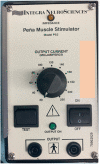Towards Zero Phrenic Nerve Injury in Reoperative Pediatric Cardiac Surgery: The Value of Intraoperative Phrenic Nerve Stimulation
- PMID: 38248878
- PMCID: PMC10816597
- DOI: 10.3390/jcdd11010008
Towards Zero Phrenic Nerve Injury in Reoperative Pediatric Cardiac Surgery: The Value of Intraoperative Phrenic Nerve Stimulation
Abstract
Background: Phrenic nerve injury is a devastating complication that results in significant morbidity and mortality. We developed a novel technique to localize the phrenic nerve and evaluate its success.
Methods: Two groups of children underwent repeat sternotomy for a variety of indications. Group I (69 patients, nerve stimulator) and Group II (78 patients, no nerve stimulator).
Results: There was no significant difference in the mean age and weight between the two groups: (6.4 ± 6.5 years vs. 5.6 ± 6.4 years; p = 0.65) and (25.2 ± 24.1 vs. 22.6 ± 22.1; p = 0.69), respectively. The two groups were comparable in the following procedures: pulmonary conduit replacement, bidirectional cavopulmonary anastomosis, aortic arch repair, and Fontan, while Group I had more pulmonary arterial branch reconstruction (p = 0.009) and Group II had more heart transplant patients (p = 0.001). There was no phrenic nerve injury in Group I, while there were 13 patients who suffered phrenic nerve injury in Group II (p < 0.001). No early mortality in Group I, while five patients died prior to discharge in Group II. Eleven patients underwent diaphragm plication in Group II (p = 0.001). The mean number of hours on the ventilator was significantly higher in Group II (137.3 ± 324.9) compared to Group I (17 ± 66.9), p < 0.001. Group II had a significantly longer length of ICU and hospital stays compared to Group I (p = 0.007 and p = 0.006 respectively).
Conclusion: Phrenic nerve injury in children continues to be associated with significant morbidities and increased length of stay. The use of intraoperative phrenic nerve stimulator can be an effective way to localize the phrenic nerve and avoid its injury.
Keywords: Peña stimulator; diaphragm paralysis; diaphragm plication; nerve stimulation; phrenic nerve injury.
Conflict of interest statement
The first author (S.M.S.) is a consultant for Artivion, JOMDD, and Abbott.
Figures





Similar articles
-
Paralysis of the phrenic nerve as a risk factor for suboptimal Fontan hemodynamics.Eur J Cardiothorac Surg. 2005 Apr;27(4):561-5. doi: 10.1016/j.ejcts.2004.12.044. Eur J Cardiothorac Surg. 2005. PMID: 15784351
-
Phrenic nerve injury after paediatric heart surgery: is aggressive plication of the diaphragm beneficial?Eur J Cardiothorac Surg. 2013 Nov;44(5):808-12. doi: 10.1093/ejcts/ezt110. Epub 2013 Mar 1. Eur J Cardiothorac Surg. 2013. PMID: 23456014
-
Impact of Phrenic Nerve Palsy and Need for Diaphragm Plication Following Surgery for Pulmonary Atresia With Ventricular Septal Defect and Major Aortopulmonary Collaterals.Semin Thorac Cardiovasc Surg. 2018 Autumn;30(3):318-324. doi: 10.1053/j.semtcvs.2018.03.004. Epub 2018 Mar 12. Semin Thorac Cardiovasc Surg. 2018. PMID: 29545034
-
Phrenic nerve paralysis and phrenic nerve reconstruction surgery.Handb Clin Neurol. 2022;189:271-292. doi: 10.1016/B978-0-323-91532-8.00003-3. Handb Clin Neurol. 2022. PMID: 36031309 Review.
-
In patients with a tumour invading the phrenic nerve does prophylactic diaphragm plication improve postoperative lung function?Interact Cardiovasc Thorac Surg. 2016 Sep;23(3):454-8. doi: 10.1093/icvts/ivw091. Epub 2016 May 24. Interact Cardiovasc Thorac Surg. 2016. PMID: 27221999 Review.
References
-
- Affatato A., Villagra F., De Leon J.P., Gomez R., Checa S.L., Vellibre D., Sanchez P., Balda D.J.I., Brito J.M. Phrenic nerve paralysis following pediatric cardiac surgery. Role of diaphragmatic placation. J. Cardiovasc. Surg. 1988;29:606–609. - PubMed
LinkOut - more resources
Full Text Sources

